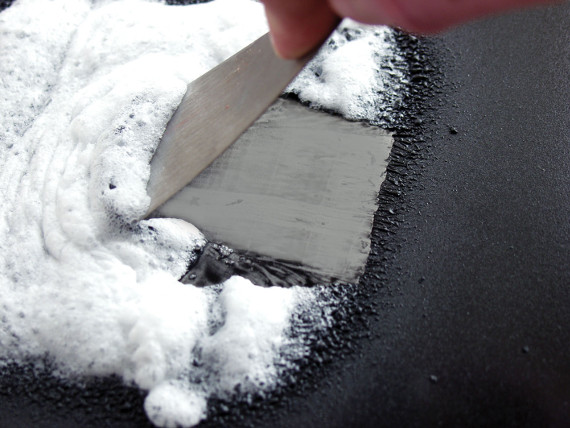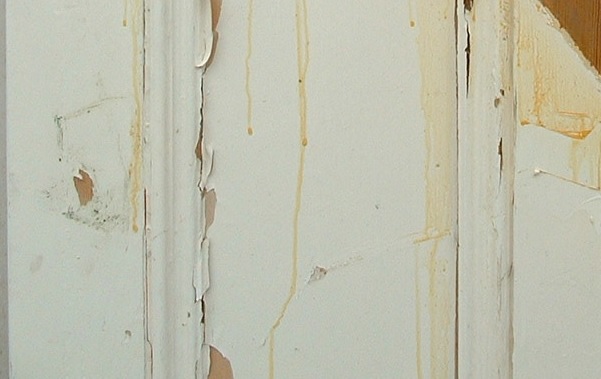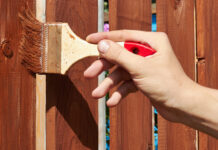Have you had problems with paint stripper? If so, you’re not alone. People are having all sorts of issues with paint removing products, through no fault of their own. So we thought it’d be useful to look at why they don’t always work, and why household name paint stripping brands that once had such a good reputation for varnish and paint removal now don’t.
Paint stripping woes – What’s going on and how to get it right
Mix a fast-changing technological and product development landscape with restrictions on the use of some of the most effective paint stripping chemicals and there’s trouble. What’s been going on?
Changes in EU regulations for paint removal products
First and foremost, changing EU regulations now mean several specific chemicals have been banned in paint strippers, making them less effective.
Both the marketing and use of products based on dichloromethane (DCM) have been restricted under REACH regulations, a restriction that mainly affects DCM-based paint strippers. The restrictions apply to the public as well as professionals, and the two-year plan was completed in late 2012. If you’d like to explore the technical details, you’ll find them here: About REACH.
Advanced paint technologies
Not so long ago, you just bought bog standard paint or varnish. There wasn’t a huge choice. Now there’s a bewildering array of paints and varnishes, some designed to tackle very demanding environments, for example spectacularly rugged outdoor paints, cement-based products and two-pack epoxy coatings.
Because every manufacturer also formulates their products slightly differently, it’s a real challenge to create an effective generic paint stripper that removes every type of paint.
- Some cement-based paints used outdoors, hard enamels and 2 pack epoxy coatings are often difficult to remove.
- Some paints containing special plasticisers can also be difficult to remove, but it depends on the type of paint and the manufacturer.
As you can imagine, things can get pretty confusing. So how do you make the most of the product you’ve bought?

Best paint stripping advice – 5 tips direct from the experts
Unless you’re 100% certain the paint stripper you’ve bought will remove a particular paint properly, it’s a good idea to carry out a careful test first. Here’s how to make the best possible job of it and give the product the best chance of doing its stuff.
- Always follow the instructions on the tin. Wear protective gloves, goggles and clothing whenever you use paint and varnish removers.
- Don’t skimp on the amount of paint remover. Apply a generous amount. If it doesn’t do the job in one hit, you can always give it a second go.
- Apply the stripping product with a brush then, after the recommended waiting time, remove it with coarse steel wool. This will help you cut into and remove the paint from the surface of the wood.
- Scrapers are also popular tools for removing the product from the wood’s surface. While they don’t scarify the surface in the same way as steel wool, they’re an excellent way to remove the product cleanly and efficiently. Try using a scraper to get the remainder of the product off the surface after using the steel wool.
- If the paint stripper removes several coats of paint but not all of them, you might need a product to tackle the deeper layers, especially if they’re a different type of paint, for example lead-based.
Recommended products for stripping paint from wood
We’re in an excellent position to provide sensible advice, since we get a lot of real-life feedback from our customers. So which paint stripping products work best under what circumstances?
About Barrettine Paint Panther
We’ve had plenty of positive customer feedback about Barrettine Paint Panther, a remarkably hard-working traditional paint removal system.
Paint Panther is a very effective paint and varnish stripper that removes as many as six paint layers in just five minutes, remarkably fast. You can use it on a wide variety of wood finishing products including water, oil and solvent-based paints, varnishes and lacquers.
Because it’s a gel, nice and thick, it’s the perfect consistency for vertical surfaces and awkward areas. In our opinion, and our customers’, it’s probably one of the best wood strippers and paint removers on the market.
We’ve provided comprehensive instructions about how to use the product on the product page itself. Just click the link above and scroll down to the ‘Overview’ section.
About Peelaway Paint Removal systems
The PeelAway Paint Removal System also comes highly recommended. There are two versions, one designed to remove older paints and another for newer types of paint. PeelAway paint removers are poultice-based. This means you apply a layer of paste about a centimetre thick to the entire surface, cover it with the special blanket and leave it for anywhere between 24 and 48 hours before removing it.
How do you use PeelAway products correctly? Here’s how…
First, buy the right product…
PeelAway 1 is perfect for older oil and lead-based coatings dating back to before 1972. You should never use PeelAway 1 to strip paint from aluminium, veneer or plywood, and it can also discolour some hardwoods, for example, Mahogany and Oak. Use PeelAway 7 instead.
If you’re really not sure what kind of paint you’re dealing with, you can buy a handy sample test pack containing PeelAway 1 and 7 so you can trial both types.
Second, use it exactly as instructed…
There’s no way around it. You can only expect the best paint removal results when you do a proper job. We’ve written detailed instructions about how to use each PeelAway system on the product page. Again, follow the links above and scroll down to the ‘Overview’ section.
There’s also some excellent video’s showing you how to use PeelAway 1 and PeelAway 7:
Need help with your paint stripping project?
For more information about paint strippers and their uses, contact our team of resident experts who are always on hand to help with project advice and product recommendations. Alternatively, see our wood stripper and remover FAQ page which covers many of the most commonly asked questions about wood strippers and removers.
We love to see before, during and after photos of any wood finishing project. If you would like to share your decking project pictures with us, you can either send us some photos or share on our Facebook, Twitter, Pinterest or Instagram pages.






Dear Sir, please can you help? After using Peelaway1 I’m starting to apply a tea made tannin to this Edwardian Clock, and noticed white patches coming through where I had to apply several layers of Peelaway. I have rinsed, sanded, neutralised & rinsed again and still the light patches remain! Please advise before I go any further! Many thanks.
Hi Cara,
It sounds like the Walnut has been sanded too finely in some areas. Try sanding the lighter areas with 150 grit sandpaper as this will open the grain and achieve greater colour pick-up. If this doesn’t resolve the issue please use our contact page and pop us some pictures over.
Hope that helps- Alison
I have been tasked with removing red masonry paint from an outside wall and have been advised to seek your recommendations as to the best products to use, it’s only 1 metre high and although I don’t know the details of the paint it’s the kind that is standard use that one sees around, your feedback would be welcomed and I would be interested in buying a sample but your sample pack contains one sample which I know would not work
kind regards Barry Conio
Good Morning Barry,
The Peelaway products are certainly the best option for your project and although it is likely you will only use one of the samples in the two pack >>> Peelaway 1 and 7 Sample Pack it is still worth getting to try test area first.
The sample allows you to see for sure if the poultice will work to strip your paint and will also give a guide to how long you need to leave it on for an how thick you need to apply it. They will help avoid opening a large tub and testing to find it may not be quite what you need, the product is then none returnable.
if you need any further support with the product and how to use correctly, please do not hesitate to get in touch via our contact us page.
kind regards Samantha.
Hi, I’m trying to strip back the staircase in our house. It is covered in a dark brown paint which when stripped leaves a residue in the wood. Once painted over it then bleeds back through the new gloss paint. The house was constructed late 1940’s. What product is best suited and safest to use.
David
Hello David,
Thank you for getting in touch with your enquiry. I have had a similar issue with a door frame in my property recently and have yet to solve the issue I am afraid to say. I am not sure what the paint type is but it leaves a real mess, that’s for sure, I would not recommend a paint burner. The only thing I am yet to try fully is one of the Peelaway Sample Pack. The Peelaway 1 is for older paint removal although not on oak.
It is a case of keep slugging away to remove it and if the Peelaway doesn’t do the job then sanding, with protective equipment/safety is going to be the only way I think. It will be worth it once it is done as you will then be able to get the desired result with a new application ( that is what I keep telling myself, anyway )
Good Luck with the project and if you have any further questions please do get in touch via our contact us Page.
All the Best Samantha
Hi
I am trying to renovate some old exterior painted oak beams in a French farmhouse built 200 years ago. I’ve tried to remove the old paint with a heat gun (no joy) and also some old Diall (b and Q) paint remover but it also seems to have no effect. I guess the paint is very old. I assume it is paint. It appears to have a white ‘undercoating’ which again I assume is a form of paint. Any suggestions other than sand blasting or using a wire brush on a drill (tried this but it would take weeks to get it all off as it really stuggles to make an inroad into the paint and suspect the paint is probably leaded and the dust a danger to health. Thanks Dave
Hi David,
Using a chemical stripper is indeed a better option to sanding or using a drill and wire brush because of the reason you pointed out, about the paint being very old and potential containing lead. Unfortunately, because paint formulations vary so much and especially so down through the ages, there is no single product that is guaranteed to remove all paints and varnishes. There are however 2 products that you could try. They both come in a sample or small tin size so can be tried to see if they are effective on the paint that you are trying to remove.
Barrettine Paint Panther is a popular product with our customers and we have had good reports of this working where other paint removers have failed. Another option is a product called peelaway 1. this is a poultice system that is applied to the paint, covered over with a special blanket (supplied), left for up to 24 hours and then peeled off. This product can be effective at removing up to 30 layers of paint in one go and is especially formulated to tackle older paint formulas. One word of caution with this product is that it is caustic-based and can discolour certain hardwoods such as oak and mahogany. For this reason, doing a test area is essential.
I hope the above helps but if you have any further questions, please feel free to contact us and speak with one of our in-house experts.
Kind regards,